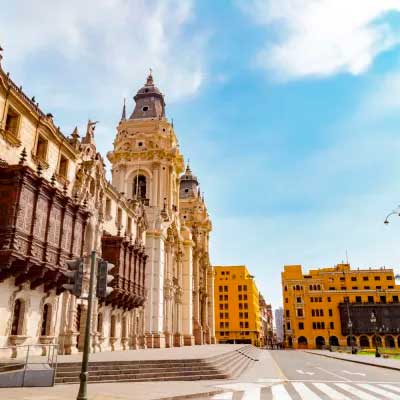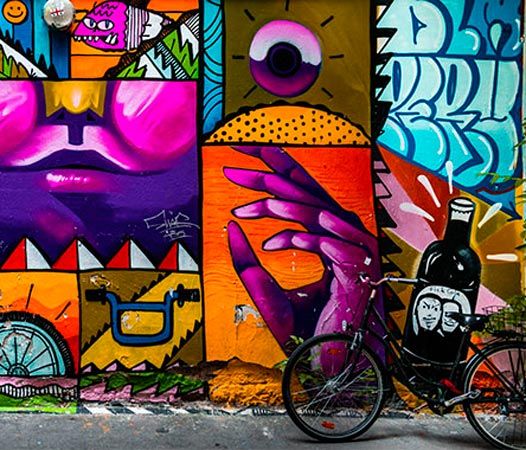



In the heart of Lima, there are two places where history, culture, and flavour come together on every corner: the Central Market and Lima’s Chinatown. This free culinary walking tour invites you to explore both, guided by a local expert who’s passionate about Peruvian cuisine.
The Central Market is a true temple of local flavour. Here, you’ll stroll past stalls overflowing with tropical fruits, native potatoes, brightly coloured chillies, and Andean medicinal herbs. Fancy tasting exotic fruits from the most remote corners of Peru? Or maybe a refreshing glass of chicha morada or a portion of the traditional arroz zambito? The choice is entirely yours!
Next, we head over to Chinatown, one of the oldest and most unique in Latin America. You’ll discover how Chinese migration influenced Peruvian food, giving birth to the famous chifa cuisine — a mouth-watering fusion of local ingredients and Chinese techniques. We’ll wander down the legendary Calle Capón, filled with lanterns, colourful shopfronts, and the irresistible aromas of soy sauce, ginger, and the five Chinese spices: Sichuan pepper, star anise, clove, fennel, and cinnamon.
But this tour isn’t just about eating — it’s about understanding Lima through its most authentic flavours. You’re not obliged to try everything, but your guide will offer suggestions that are very hard to resist. Every bite is a little taste of Peru.
And of course, we finish the experience with a toast of pisco sour, the iconic cocktail that captures the joy and flavour of Peru.
CULINARY DELIGHTS
Papa a la huancaína
What could possibly go wrong when you bring together a few slices of our age-old Peruvian potatoes with a creamy mix of fresh cheese, ají amarillo (yellow chilli – just the right amount of spice to tease the taste buds), milk, and a bit of bread or crackers?
And since nothing can go wrong, this simple combination has become one of the most beloved starters in Peruvian cuisine. That’s why you’ll find it being served in markets, restaurants, and homes all across the country.
It’s usually presented on a leaf of lettuce, which acts as a base for the boiled potatoes. The finishing touches? A black olive and slices of hard-boiled egg, placed neatly on top – the little details that “crown” the dish.
Legend has it that this dish began rising in popularity during the 19th century, when women from Huancayo – a city in the central highlands – would sell “potatoes with cream” at train stations along the railway line connecting their hometown to the capital.

Ceviche (or cebiche)
It doesn’t matter how you spell it – what truly matters is the fresh, zesty, and slightly spicy flavour of our national dish. Simple and generous, ceviche doesn’t require fancy cooking techniques or a long list of ingredients. Quite the opposite.
All you need are cubes of fresh fish, marinated in the sharp juice of northern Peruvian limes, ají limo (a key ingredient that brings the heat), red onion, a bit of coriander, and a magical touch of salt and pepper. Once served, it’s typically accompanied by cancha serrana (toasted corn), corn kernels, or sweet potato.
This dish dates back to pre-Hispanic times. On the northern coast of Peru, it’s known that the Mochica people used to “cook” fish using the juice of tumbo, a native citrus fruit. After the arrival of the Spanish, lime from Asia began to be used instead.
Blessed by the Pacific Ocean, Lima is truly a ceviche capital. In recent years, new versions of this sea-and-land fusion dish have appeared, keeping the tradition alive and exciting. For that – and many other reasons – ceviche has been declared a Cultural Heritage of the Nation.

Ocopa
From the convents and grand colonial houses of Arequipa to dining tables across the country – that’s the journey of this beloved starter from the “White City”, which has won over food lovers with its rich blend of boiled potatoes and a creamy, flavourful sauce.
Unlike huancaína sauce, ocopa is made with ají mirasol (dried yellow chilli), toasted peanuts, and huacatay leaves – an aromatic herb native to the Andes. It also includes fresh cheese, milk, and either bread or crackers. The dish is served with a boiled egg and a black olive on top.
Ocopa’s sauce is a perfect example of how native herbs are used in Peruvian cooking. These ingredients bring a special flair to a cuisine that blends Andean roots with Spanish techniques and products. Thanks to its exceptional taste, ocopa has gone beyond its regional origins and become a national dish that represents Peru’s culinary fusion. You’ll soon understand why it’s one of the most popular starters on criollo menus all over the country.

Chicha morada
Ancestral and 100% natural, chicha morada is the perfect companion to criollo food. Made from purple corn – an Andean variety packed with antioxidants – it’s the most popular non-alcoholic drink in Peru’s capital.
With its deep purple colour, chicha is made by boiling purple corn with ripe pineapple, cinnamon sticks, cloves, and quince. Once it reaches boiling point, the mixture is strained, sweetened with sugar, and finished off with a splash of fresh lime juice.
The result is a refreshing drink with ancient roots. It’s known that pre-Hispanic cultures used chicha in their rituals and religious ceremonies, which is why maize was considered sacred.
Chicha morada is not only delicious, but also full of antioxidants and good for your health. Don’t miss the chance to try it – you’ll love it, and in a way, it’ll give you a little taste of Peru’s ancient Andean soul.

Siu mae and min pao
In Lima, classic Chinese snacks have a unique flavour – the flavour of fusion. This culinary blend began to take shape in the late 19th century, when Cantonese immigrants settled in the capital.
It was in Lima’s Chinatown where foreign ingredients and local flavours first came together in sizzling woks. This gave rise to chifas – Chinese-Peruvian restaurants where Chinese food is served with a distinct touch of Peruvian flair.
That’s one of the reasons why siu mae and min pao have been embraced as our own by the people of Lima. These two bites perfectly reflect the cultural fusion that feeds and enriches our local cuisine.
Don’t hesitate to give them a try! Siu mae (or shumai) is a small steamed dumpling made with rice dough and filled with meat, while min pao is a soft bun stuffed with sweet or savoury fillings – usually pork or chicken – and cooked either steamed or baked.

Fruit juices at the central market
Treat yourself to a full sensory experience in the main food market of Lima’s Historic Centre. Here, the friendly caseritas (market ladies) whip up powerful juices using passion fruit, soursop, lúcuma, camu camu, mango, pineapple, and many other fruits.
It’s a true festival of colours and flavours, bringing together fruits from Peru’s coastal, Andean, and Amazonian regions. These natural drinks are not only delicious, creative, and energising – they’re also nourishing and great for your health.
Served generously – and with a little yapa (that extra splash of juice they add when you finish) – the juices often include herbs like alfalfa or exotic fruits like noni.
Some even get a boost from algarrobina (a syrup made from carob), honey, or a splash of dark beer to make them even stronger. Still need more reasons to try one? Here’s one more: with every sip, you’re tasting a bit of Peru’s incredible biodiversity.

Picarones
A traditional sweet treat made for those with a sweet tooth! Drizzled with chancaca syrup (a rich, spiced syrup made from unrefined cane sugar and flavoured with cinnamon, cloves, and orange peel), picarones are a delicious temptation from Lima that date back to colonial times.
Although they may look a bit like doughnuts, picarones are truly one of a kind in terms of how they’re made, their texture, and their flavour. But they’re more than just tasty – they’re also a symbol of identity for the people of Lima and an icon of traditional Peruvian street desserts.
This colonial-era delight is made from a fermented dough using flour, squash, and sweet potato. Once the dough is ready, the picaronera (the person making them) skillfully shapes a ring and drops it into hot oil to fry. The result? A crispy ring on the outside with a soft, warm centre.
Tradition says you should eat them with your hands, dunking each piece into generous amounts of chancaca syrup. Only then can you truly say they’re “finger-licking good”!

Queso helado (literally “frozen cheese”)
Don’t be fooled by the name – when you order this dessert, you won’t be getting slices of cheese straight out of the freezer. And no, the “frozen” bit doesn’t mean it comes from the icy peaks of the Andes either.
Neither is true, for one simple reason: queso helado contains no cheese at all – not even a hint. It’s actually made with milk that’s kept cold in a traditional metal container surrounded by plenty of ice.
With a texture similar to artisanal ice cream, this colonial-era dessert from Arequipa – believed to have been first prepared in the Santa Catalina convent – is made using milk, grated coconut, cinnamon, and cloves. And although it hails from the “White City”, queso helado is also enjoyed in Lima. Thanks to its unique flavour and rich history, it’s becoming more and more popular at food fairs, markets, and restaurants across the capital.

Mazamorra morada with arroz zambito
Two classics on one plate – that’s the essence of the combinado, which brings together two colonial-era desserts: mazamorra morada and arroz zambito. Try them warm and steaming, and you’ll see – there’s nothing quite like it.
Limeños are true mazamorra lovers, and of all the varieties, the purple one is the most iconic. Maybe it’s because it shares the colour of the Señor de los Milagros, the city’s patron saint, or perhaps because it’s closely related to the much-loved chicha morada.
Made with purple corn, dried fruits, sugar, and cinnamon, mazamorra morada shares the spotlight with arroz zambito – a very criollo version of rice pudding. The key difference? It’s made with chancaca, giving it that deep, rich colour and unique flavour.
This comforting combo, which started out being sold from street carts, is now a homemade favourite and proudly featured on the menus of Peruvian restaurants. After all, food culture isn’t static – it changes, evolves, and reinvents itself.

Pisco sour
Try the most famous Peruvian cocktail in the world – pisco sour! This iconic drink is made by pouring pisco (a high-purity, top-quality grape brandy) into a shaker with ice, where it’s blended with fresh lime juice, egg white, and a few drops of Angostura bitters.
The invention of the pisco sour is credited to American bartender Victor Morris, who in the 1920s had the brilliant idea of creating this drink at his Morris Bar, right in the heart of Lima.
In Peru, pisco is far more than just a spirit. It’s our national drink, with a story that began in the 16th century, when grapevines brought over by the Spanish first flourished in the coastal valley of Ica. So, how could you not end your culinary walking tour through the streets of Lima with a glass of pisco sour in hand? After all, you’re in the capital of Peru – and one of the world’s great food capitals. Cheers to you, and to the limeños who keep the flavour alive!

TIMETABLE & LANGUAGE
| Schedule | Language | Duration | |
|---|---|---|---|
| 12:45 | From Monday to Saturday | English | 2 h |
| 12:30 | From Monday to Friday | Spanish | |
| We don’t operate on the 28th and 29th of July. This tour will not be running from the 16th of December to the 3rd of January. | |||
WHERE?
Meeting point: In front of La Merced Church—next to the statue of Ramón Castilla. Look for our Partner wearing a black T-shirt and/or vest with “Walking Tour” written on the back.

DETAILS
Tour Type:
- Group service.
Price:
- Booking is free.
- At the end of the tour, please leave your donation—some leave US$ 15 pp or S/ 50 pp, others leave more.
- Donations must be in cash; cards or other forms of payment are not accepted.
Restrictions:
- People with reduced mobility.
- Peruvians (this tour is only available to foreigners).
Included:
- Professional tour guide.
Not included:
- Donation (tips).
- Personalized service.
What do I bring?
- Sweaters.
- Good walking shoes.
- Caps or hats.
- Sunglasses.
- Sunscreen.
- Cash for:
- Donations: US$ 15 pp or S/ 50 pp on average.
- Food tastings: S/ 70 soles pp on average.
Operation and itinerary:
- The itinerary of this free tour is subject to change without prior notice due to strikes, guide’s decisions, or any other event that prevents the tour from running smoothly.
- Our operators always do their best to ensure an engaging tour.
PARTNER



This tour isn’t organised directly by Free Walking Tours Peru LLC, but by our local partner Joan Manuel Lozano — a passionate and highly experienced guide carefully selected by our team of tourism product specialists. This collaboration allows us to keep offering you authentic and memorable experiences in the city of Lima. At FWTP, we’re committed to working with the best local partners, so you can continue exploring each destination with guides who truly love sharing the history and culture of their city with every walker.



Hello! I’m Joan Manuel Lozano, a professional guide and a passionate ambassador of tourism in Lima. I love sharing the history of my city, its cultural secrets and, of course, its exquisite cuisine. Peruvian food is one of my greatest passions, and on this tour I’ll take you on a journey to discover authentic flavours that are sure to surprise you. I enjoy offering a warm, friendly service full of great stories. If you’d like to eat well and explore the Peruvian capital from a different perspective with expert guides, my team and I would love to have you join us on this tour.

Joan Manuel
Official guide

José Francisco
Official guide
REVIEWS
Please, scroll down to see reviews.
REVIEWS
⭐Google Maps: 900 reviews | ⭐TripAdvisor: 400 testimonials | ⭐Facebook: 50 comments | ⭐Instagram: 5000 followers | ⭐YouTube: watch our videos | ⭐Travellers: + de 365 tourists
























